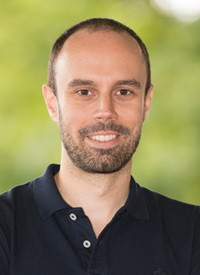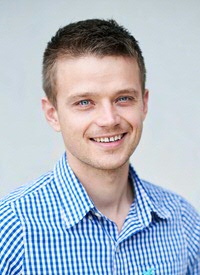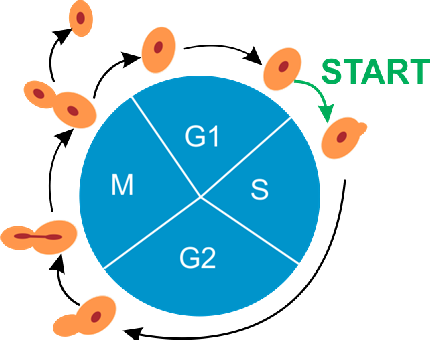Using artificial intelligence to accelerate research into the cell cycle of yeast cells

Yeast cells. You’ve probably heard about them. They are the single-celled moulds that we have been using for centuries to make wine, beer and bread. But did you also know that yeast cells are used for cancer research? Data scientists from the University of Groningen’s Center for Information Technology (CIT) are helping researchers to visualize the cell cycle of yeast cells using artificial intelligence. ‘We’re still discovering things we’ve never even heard of before.’
The next time you are sat in the sun enjoying a glass of wine or a beer, having a slice of toast for breakfast or guzzling a bar of chocolate with your coffee, just remember – you have yeast to thank for that. What is perhaps less well known, but no less important, is that yeast cells have been proving their worth as model organisms in microscopic biological research for many years. Despite their simple structure, they bear many similarities to more complex eukaryotic cells, such as human cells.
Accelerating research with AI
Many complex biological processes, such as cell division or the spread of cancer cells, were discovered using yeast cells. And yet, our knowledge of yeast cells is still relatively limited. ‘For a long time, biologists thought that they knew how cells worked. But then microscope research took off, and we discovered a lot of new things,’ says Andreas Milias-Argeitis, Assistant Professor of Molecular Systems Biology at the University of Groningen. He researches the budding yeast cell cycle, in other words, the series of steps a yeast cell goes through in order to divide. ‘We are investigating how cells grow during their cell cycle. For a long time we thought that cell growth was a ‘passive’ process that took place continuously during the cell cycle in response to nutrient availability, but we discovered that it is actually a process that is very carefully orchestrated in time and coupled to the progression through the cell cycle.’ Milias-Argeitis is working on a project to accelerate research into the cell cycle of yeast cells using artificial intelligence. ‘For the last few years we have been taking pictures of the different phases of the yeast cell cycle, which takes about two hours in total. But if you photograph the entire cycle in hundreds of cells, it’s very hard to find the exact moment at which budding occurs and when the daughter separates itself from the mother cell. So we want to automate that.’

‘Cheated’ with data
And so Milias-Argeitis signed up for the CIT’s Data Science team’s annual call for proposals. His research proposal was selected – and he received the help of data scientist Herbert Kruitbosch, who has years of experience in image processing (using machine learning to process images). ‘Actually, I cheated,’ says Kruitbosch. ‘I needed a lot of data for this project. You don’t just need the photos, you also need notes about what exactly is going on at that precise moment. That would usually take researchers a lot of time. But when I looked at the images, I noticed that the cell structure was fairly easy to imitate with data. So I fed a machine learning model with 200 GB worth of images that I had created myself.’ To check whether the findings from the data he created matched reality, he built in a double control with the original data. ‘First I looked at how many yeast cells the algorithm had recognized. Then I checked all the places where the algorithm detected a yeast cell to see whether there was one. And luckily, there was.’

Disrupting the cell cycle
Now that the algorithm is able to efficiently recognize yeast cells, it is time for the next step: recognizing the yeast cell’s different phases of life – from when budding occurs on the mother cell, to the moment the bud grows into a new cell and finally tears itself away from the mother cell. Milias-Argeitis also wants to find out exactly how much time passes between these different phases. Under normal circumstances, the cell cycle of yeast cells is very predictable, which is why he sometimes tries to influence or strongly disrupt normal cell growth using a variety of impulses. ‘We want to see what happens if we disrupt their growth processes. How will their cell cycle adapt?’

Translating to more complex cell structures
Such tests can provide a lot of information about how cell division works, or how cells react to stimuli. However, there are huge differences with human cells, for example, explains Milias-Argeitis. ‘Our cells are influenced by all kinds of external stimuli and have many more functions than just growing and dividing: they exchange hormones and information and they communicate with each other. But the process of cell division in yeast cells and human cells is largely the same. We are trying to get to the bottom of that. But we are also already thinking about how we can translate our findings to more complex cell structures.’
Breaking through your own bubble
That is quite a striking statement. At a time when the fight against cancer is a top priority in medical science, we still know very little about the most fundamental processes that take place in cells. This is partly because technology is not yet accessible to everyone. ‘Only recently have some biologists started filming cells over a longer period of time. This requires specific software and a great deal of expertise,’ explains Milias-Argeitis. And that software and expertise often remain in-house. ‘Algorithms are often built with a specific research question in mind. Few researchers publish anything about them, so that knowledge is lost when the project is over. And when studies appear, they often contradict each other because they use different methods. That’s why I hope this project will allow me to develop a user-friendly tool that can easily be adapted to different purposes. We need to start speaking the same language.’
Added value of data science
Milias-Argeitis believes that cross-fertilization with other disciplines, as well as more contact between biologists, is desperately needed in order to progress. Given his background in electrical engineering, he is more than aware of the added value that data science can have. ‘As is the case for other biologists, all kinds of questions crop up when we are experimenting in the lab. Sometimes I talk to computer scientists to help me answer those questions. There are still so many things that biologists still haven’t found answers to; data scientists can help.’
Meer informatie
Author: Jorn Lelong
| Last modified: | 17 December 2024 08.57 a.m. |
More news
-
03 April 2025
IMChip and MimeCure in top 10 of the national Academic Startup Competition
Prof. Tamalika Banerjee’s startup IMChip and Prof. Erik Frijlink and Dr. Luke van der Koog’s startup MimeCure have made it into the top 10 of the national Academic Startup Competition.
-
01 April 2025
NSC’s electoral reform plan may have unwanted consequences
The new voting system, proposed by minister Uitermark, could jeopardize the fundamental principle of proportional representation, says Davide Grossi, Professor of Collective Decision Making and Computation at the University of Groningen
-
01 April 2025
'Diversity leads to better science'
In addition to her biological research on ageing, Hannah Dugdale also studies disparities relating to diversity in science. Thanks to the latter, she is one of the two 2024 laureates of the Athena Award, an NWO prize for successful and inspiring...
